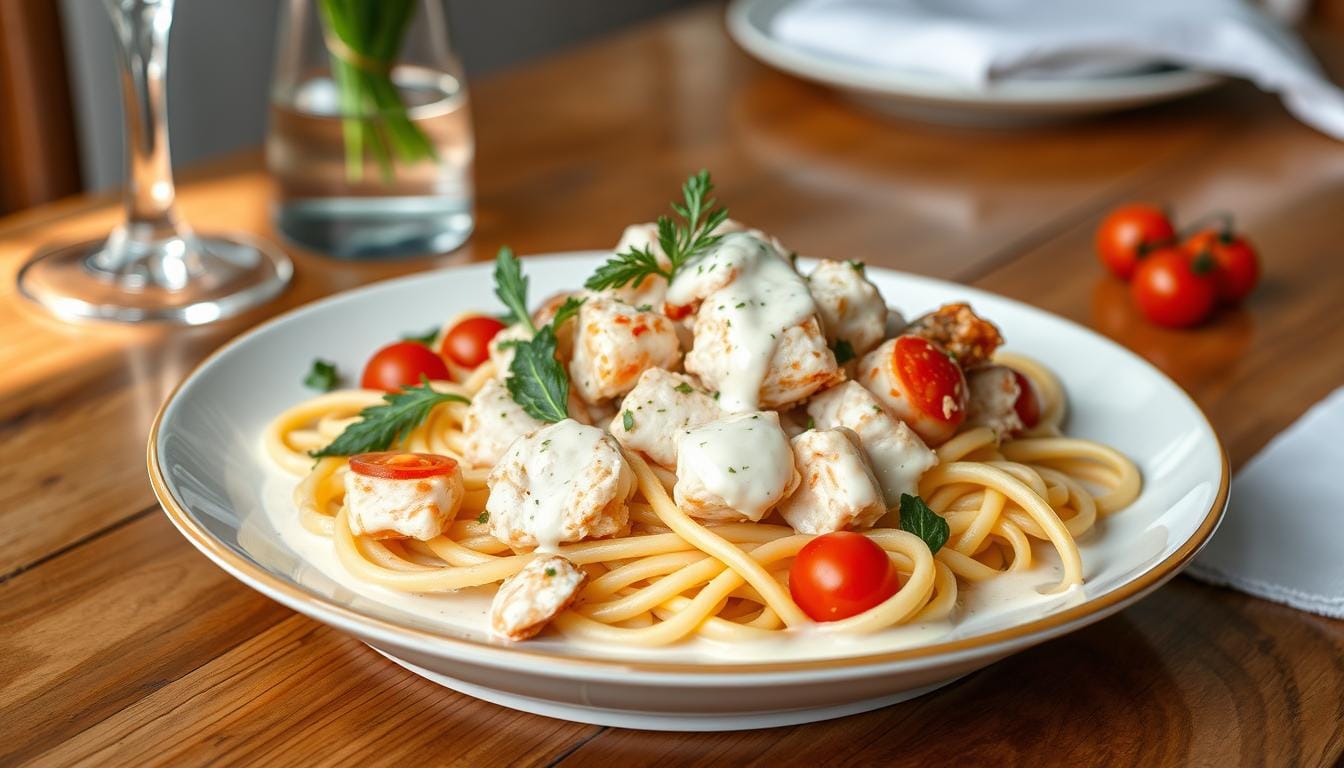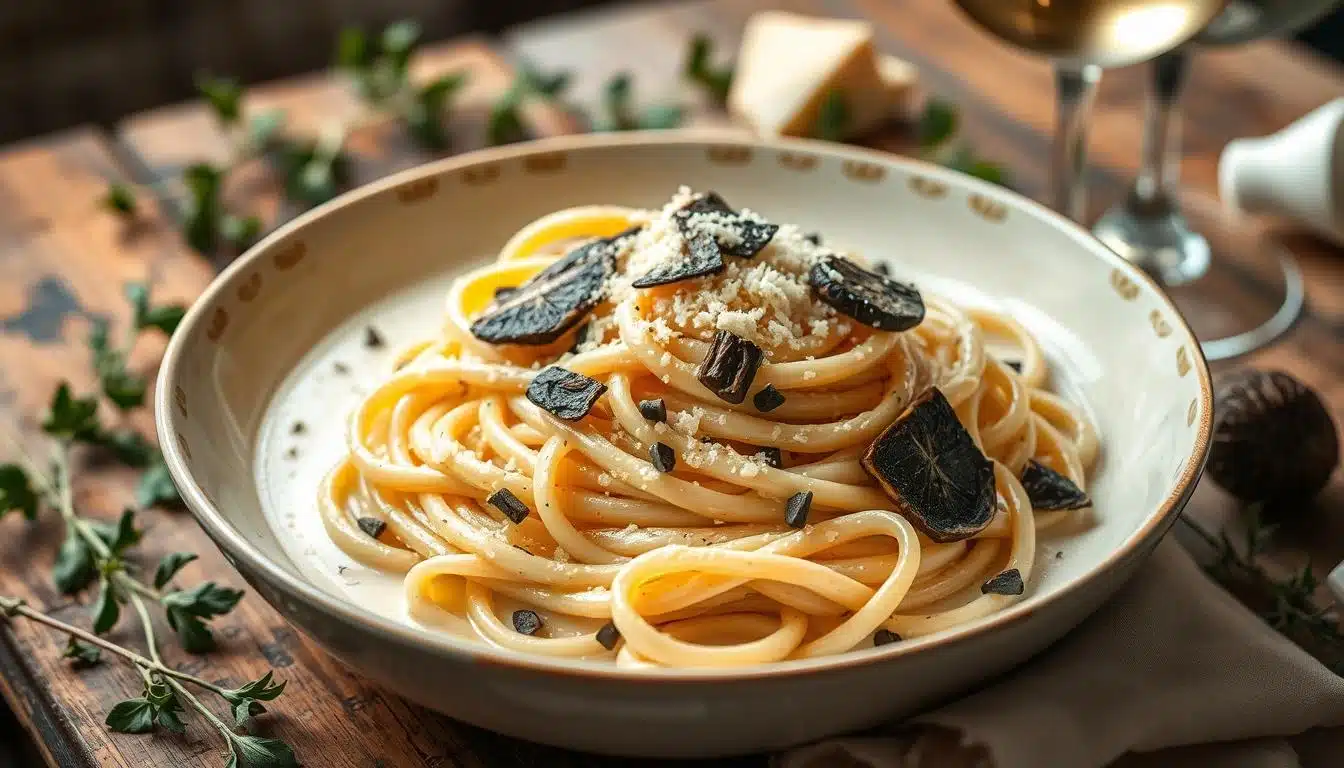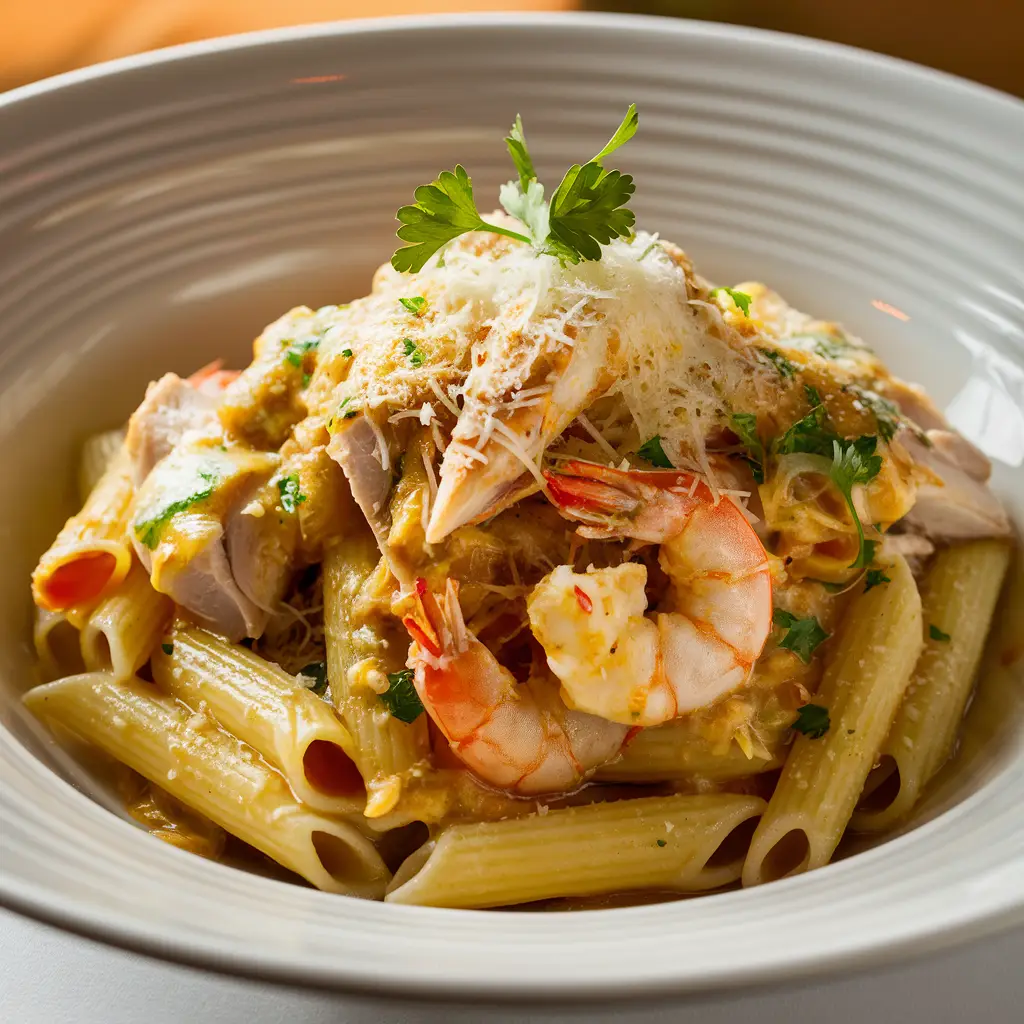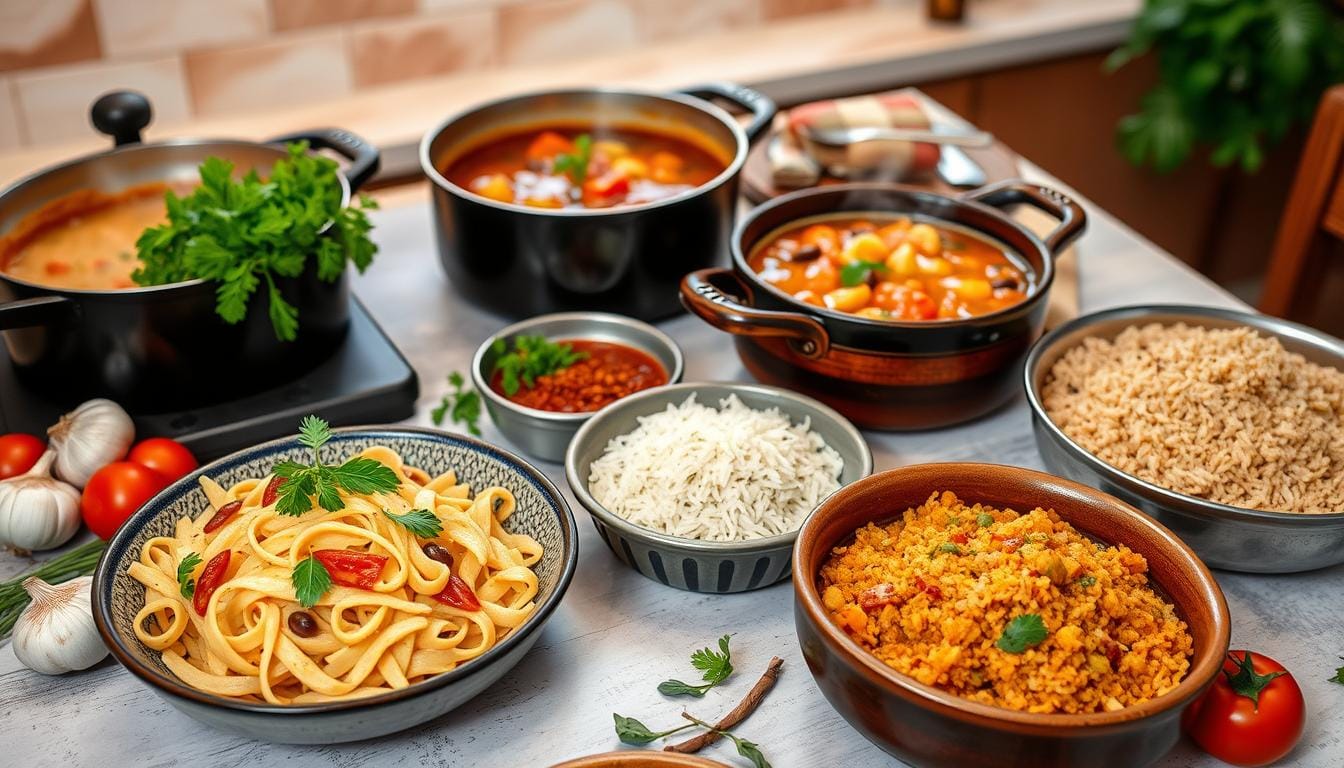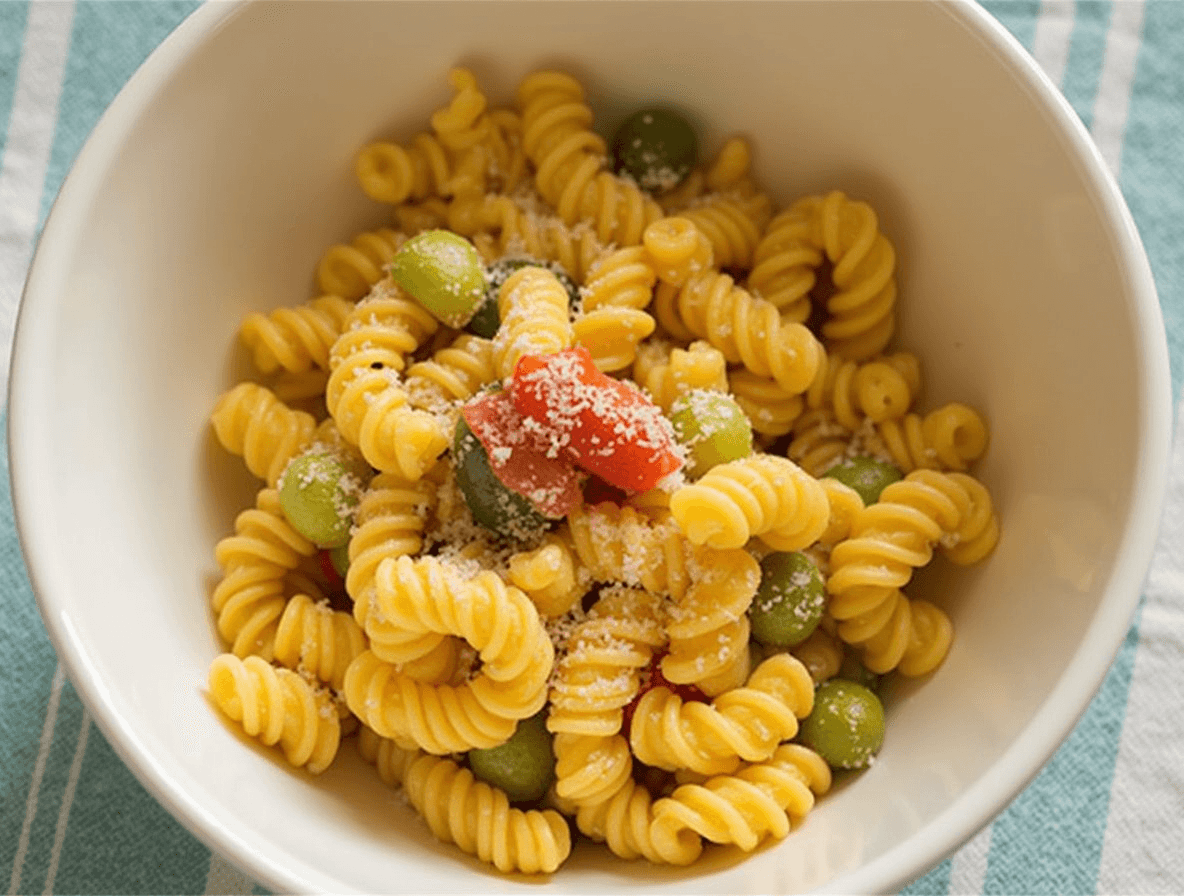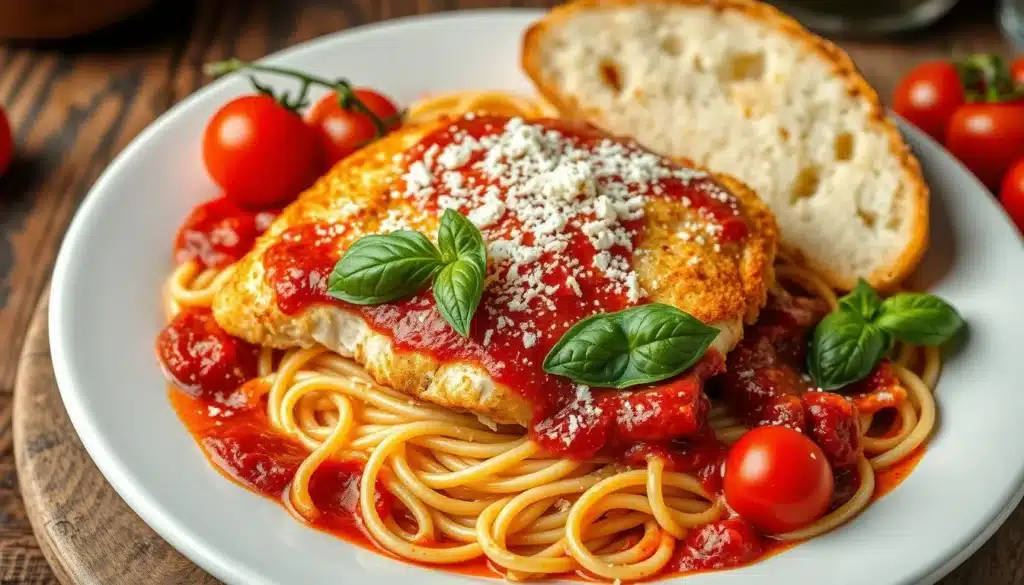Creamy Salmon and Shrimp Pasta: A Tempting Dish

Table of Contents
Creamy Salmon and Shrimp Pasta is a mix of tender salmon, juicy shrimp, and a smooth cream sauce. It’s a comforting dish that’s perfect for any dinner. The salmon and shrimp pasta is loved for its rich flavors and fresh ingredients, making it a top choice in many U.S. kitchens.

A creamy, luscious pasta dish in a white ceramic bowl, featuring tender salmon fillets and succulent shrimp nestled in a rich, velvety sauce. The pasta is perfectly al dente, coated in a smooth, dreamy sauce that glistens under soft, diffused lighting. The salmon and shrimp are arranged artfully, their colors complementing each other and the pasta. Sprigs of fresh dill and a light dusting of cracked black pepper add the final touch of elegance to this tempting, appetizing scene, set against a minimalist, clean background that allows the dish to take center stage.
Find out how to make this dish from scratch. Learn about choosing the best seafood, blending sauces, and presenting it beautifully. This guide will help you create a meal that rivals a restaurant’s quality at home.
Key Takeaways
- Salmon and shrimp pasta offers a luxurious yet approachable meal option.
- Classic cream sauces enhance seafood flavors without overpowering them.
- Adjust cooking times based on preferred seafood doneness.
- Pair with sides like garlic bread or salads for balance.
- Present the dish with fresh herbs for vibrant table appeal.
The Allure of Seafood Pasta Dishes
Seafood pasta dishes are loved around the world for their mix of flavors and textures. They combine light, briny seafood with hearty pasta, making meals that are both fresh and comforting. Whether it’s creamy shrimp fettuccine or lemony cod linguine, these dishes are favorites in many kitchens.

A delectable Italian seafood pasta dish, featuring tender shrimp and succulent salmon nestled in a creamy, savory sauce. Vibrant tomatoes, aromatic herbs, and al dente pasta create a visually stunning and mouthwatering composition. The scene is bathed in warm, soft lighting, highlighting the dish’s alluring textures and flavors. The camera angle offers a close-up, intimate perspective, inviting the viewer to appreciate the dish’s intricate details and the harmony of its ingredients. The overall atmosphere is one of rustic elegance, perfectly capturing the essence of a tempting, irresistible seafood pasta creation.
Why Seafood and Pasta Make a Perfect Pairing
Seafood’s light taste goes well with pasta’s sauce-absorbing nature. Al dente spaghetti holds onto garlicky shrimp, while wide lasagna noodles soak up clam sauces. This combo works in many cuisines, from garlicky scampi pastas to spicy shrimp aglio e olio.
The Italian Influence on Seafood Pasta
Italian seafood pasta has a long history. Coastal areas like Sicily and Campania are known for dishes like pasta con le sarde (sardine pasta) and linguine alle vongole (clam linguine). These recipes use simple ingredients like olive oil, garlic, and fresh herbs to showcase seafood’s flavor. Chef Massimo Bottura says,
“Seafood pasta is poetry: the sea’s essence meets Italy’s culinary soul.”
Rising Popularity in American Cuisine
In America, Italian seafood pasta has grown into something new and exciting. Restaurants now offer dishes like salmon and shrimp pasta with international twists, like coconut-lime shrimp linguine or spicy tuna fusilli. These modern dishes show how classic Italian ideas can inspire new creations.
Health Benefits of Salmon and Shrimp in Your Diet
Seafood pasta is a great choice for those who care about their health. Salmon and shrimp are full of nutrients and don’t make you feel guilty. Salmon has omega-3 fatty acids that are good for your heart and brain.
These healthy fats can also help fight inflammation, which is linked to many diseases. Shrimp, on the other hand, is low in calories but high in protein. It also has vitamin B12 for energy and selenium to boost your immune system.

A delectable seafood pasta dish featuring succulent salmon and juicy shrimp. The pasta is cooked al dente and coated in a creamy, lightly-seasoned sauce. Vibrant cherry tomatoes, fresh basil, and a sprinkle of Parmesan cheese add pops of color and flavor. Soft lighting illuminates the dish, highlighting its fresh, wholesome ingredients. The composition is balanced, with the pasta noodles flowing gracefully across the frame. Captured at a low angle, the image emphasizes the dish’s appetizing, nutritious nature, reflecting the health benefits of its star ingredients – omega-3-rich salmon and protein-packed shrimp.
- Omega-3s in salmon lower bad cholesterol and support brain health.
- Shrimp’s high-quality protein aids muscle repair with minimal calories.
- Both seafood types offer zinc and iodine, vital for thyroid and metabolic functions.
Don’t worry about cream sauces adding too many calories. Try garlic-herb blends or lemon-tarragon instead. Pair it with whole-grain pasta for extra fiber. Choose wild-caught salmon and MSC-certified shrimp for a sustainable choice without losing flavor.
“Including seafood twice weekly aligns with dietary guidelines for heart health,” says the USDA.
Healthy seafood pasta is not a treat; it’s a way to eat well. By using fresh ingredients and smart cooking, you can make a dish that’s both tasty and healthy. Your meal becomes a step towards better health, one bite at a time.
Essential Ingredients for the Perfect Salmon and Shrimp Pasta
Mastering this dish starts with choosing the right ingredients. Every component—from seafood to sauce—plays a role in balancing flavors and textures. Let’s break down what makes each part shine.
Selecting the Freshest Seafood
Quality begins with fresh salmon and shrimp. Look for salmon with firm, shiny flesh and a mild ocean scent. Shrimp should feel springy and have a faint sweet aroma—not fishy. Opt for wild-caught options like Alaskan salmon or Gulf shrimp for sustainability. Frozen seafood from reputable brands works well too, just thaw slowly in the fridge.
Pasta Varieties That Complement Seafood
Choose pasta shapes that cradle the sauce and seafood. Try:
- Linguine or fettuccine for coating in creamy sauces
- Orecchiette to trap bits of salmon and shrimp
- Gluten-free chickpea pasta for a protein boost
Boil pasta until al dente to keep it from getting mushy when mixed with hot ingredients.
Creating a Flavor Base: Aromatics and Herbs
Start with a base of minced shallots and garlic sautéed in olive oil. Add fresh herbs like dill for brightness or parsley for freshness. A sprinkle of lemon zest can elevate the dish without masking the seafood’s natural taste.
Cream Sauce Foundations
A silky sauce balances richness and lightness. Use heavy cream for a classic pasta with salmon or opt for crème fraîche for tanginess. Thicken sauces by reducing heat gently—never boil—or whisk in a butter-and-flour roux. Always taste before adding salt, as shrimp can be briny.
Pair these elements thoughtfully, and your pasta with salmon becomes a dish that highlights each ingredient’s best qualities. Next, let’s dive into the tools you’ll need to prepare everything smoothly.
Kitchen Equipment You’ll Need
Mastering homemade seafood pasta starts with the right tools. Even basic equipment ensures your dish turns out perfectly every time. Here’s what you’ll need to gather before you begin:
- Large pasta pot: A pot at least 6 quarts in size prevents overcrowding—essential for proper pasta cooking techniques.
- Slotted spoon: Ideal for gently removing shrimp and salmon from boiling water without breaking them.
- Heavy-bottomed skillet: Distributes heat evenly for sautéing and sauce-making without burning ingredients.
- Sharp chef’s knife: Cuts salmon fillets cleanly and trims shrimp tails efficiently.
- Microplane grater: Perfect for zesting lemons or grating Parmesan into sauces.
| Essential | Optional but Helpful |
|---|---|
| Colander | Pasta machine (for fresh noodles) |
| Wooden spoon | Seafood deveiner |
| Cheesecloth | Immersion blender |
Quality doesn’t have to mean expensive. A basic set of these tools works wonders. For example, a cast-iron skillet doubles as both a saucepan and frying surface. If you lack a thermometer, check salmon doneness by flaking it with a fork. Every tool listed serves multiple purposes, making this setup accessible for any kitchen. Enjoy the process—great results come from smart preparation!
Preparing Your Seafood for Pasta Perfection
Perfect seafood pasta dishes start with properly prepared ingredients. Follow these steps to ensure your fresh salmon and shrimp shine in every bite.
Cleaning and Deveining Shrimp
For clean, tender shrimp:
- Remove the shell, leaving the tail on for presentation or off for easier eating.
- Use a sharp knife to cut along the shrimp’s back, exposing the vein. Rinse under cold water.
- Pat dry thoroughly before cooking to avoid sogginess.
Salmon Preparation Techniques
Cut salmon into:
- Fillets: Slice skin-on portions for even cooking.
- Cubes: Dice into bite-sized pieces for even distribution in pasta.
Optional: Remove pin bones with tweezers. For texture, cook salmon gently in sauce or pre-sear it for extra flavor.
Marinating Options
Elevate flavors with these marinades:
- Lemon-Herb: Combine olive oil, lemon juice, garlic, and parsley. Marinate shrimp 15–30 minutes.
- White Wine: Mix white wine, thyme, and butter for salmon. Let sit 10–15 minutes.
- Quick Garlic: Toss with minced garlic, olive oil, and salt. Use 5–10 minutes before cooking.
Over-marinating can toughen delicate proteins. Always pat dry before adding to pasta sauces.
Step-by-Step Guide to Creamy Salmon and Shrimp Pasta
Ready to make this salmon pasta recipe shine? Follow these easy steps to whip up the creamy shrimp pasta sauce. It’s all about timing—start by cooking pasta in salted water. Then, remove it 1 minute before it’s al dente to finish in the sauce.
- Heat olive oil in a large pan over medium heat. Add minced garlic and shallots, sauté until fragrant—1-2 minutes. Avoid burning!
- Cook shrimp in the same pan 2-3 minutes per side until pink. Transfer to a plate, leaving juices in the pan.
- Add salmon fillets skin-side down to the pan. Cook 4-5 minutes until crispy, flip gently, and cook 2 more minutes. Remove with a spatula.
- Reduce heat to medium-low. Pour in heavy cream and ¼ cup pasta water. Stir until slightly thickened, about 3 minutes.
- Return cooked pasta to the pan. Add shredded parmesan, butter, and a pinch of red pepper flakes. Toss vigorously to coat, adding more pasta water if too thick.
- Layer shrimp and salmon slices back into the pasta. Gently fold in to keep fish tender. Sprinkle with parsley.
- Serve immediately with extra parmesan and lemon wedges. Garnish with chili flakes for heat.
Pro tip: Overcooked shrimp get rubbery—always undercook them slightly here! For the creamy shrimp pasta sauce, never walk away while reducing cream—it can scorch easily. Your kitchen will smell like a trattoria in no time!
Sauce Variations to Elevate Your Seafood Pasta
Turn your creamy seafood pasta into a journey of flavors with these creative sauce ideas. Whether you want something rich or something zesty, these seafood pasta sauce variations will satisfy any craving.
White Wine & Cream Innovations
Enhance your creamy seafood pasta with white wine’s sharpness. Use Pinot Grigio for a crisp taste or Chardonnay for a buttery feel. To avoid lumps, slowly add cream while heating on low. Add capers for a salty kick or lemon zest for a burst of freshness. Tip: First, reduce the wine to intensify the flavor before mixing in cream.
Tomato-Based Twists
For a lighter choice, mix sun-ripened tomatoes with garlic and basil. Add vodka for a smooth seafood pasta sauce, or pesto for a herbaceous twist. To balance the flavors, slowly cook the tomatoes. This complements the sweetness of shrimp.
Olive Oil & Garlic Simplicity
Choose a Mediterranean vibe with extra-virgin olive oil and roasted garlic. Toss pasta in this aromatic mix, then top with parsley and red pepper flakes. For more flavor, add lemon juice or Parmesan rind while cooking.
| Sauce Type | Key Flavors | Signature Ingredients |
|---|---|---|
| Creamy | Rich, velvety | Heavy cream, white wine, butter |
| Tomato | Herbaceous, tangy | Fresh tomatoes, basil, garlic |
| Olive Oil | Herb-forward, light | Extra-virgin olive oil, rosemary |
Wine and Beverage Pairings for Salmon and Shrimp Pasta
Make your creamy seafood pasta even better with the right drinks. Whether you like wine or something else, the perfect match makes your meal special.
White Wine Selections
For seafood wine pairings, crisp whites are the best. Here are some top picks:
| Wine Type | Recommendation | Price Range |
|---|---|---|
| Sauvignon Blanc | Kim Crawford or Honig Vineyard | $15–$30 |
| Unoaked Chardonnay | Cakebread or Franzia | $12–$25 |
| Pinot Grigio | Ruffino or Banfi | $10–$20 |
Rosé Options
Dry rosés brighten up creamy seafood pasta. Here are some great choices:
- Provençal-style rosés like Château d’Esclans or Whispering Angel
- Domestic picks: Fableist or Qupé
Non-Alcoholic Pairing Suggestions
- Sparkling water with lemon or lime wedges
- Cucumber-mint infused water for freshness
- Non-alcoholic “wine” alternatives: La Marca White or Seedlip Grove 42
Keep white wines cold (45–50°F) and use clear glasses. Try different drinks to find your favorite. Enjoying great food and drink is always a good choice!
Nutritional Information and Dietary Considerations
A standard serving of creamy salmon and shrimp pasta has about 600-700 calories. Salmon and shrimp provide 35-40g of protein. The pasta and cream add carbs and fats, but healthy seafood pasta can fit many diets. Knowing these parts helps balance taste and nutrition.
- Low-Carb Option: Swap regular pasta for zucchini noodles or shirataki noodles to cut carbs by 50%.
- Dairy-Free: Substitute coconut milk or cashew cream for traditional dairy-based sauces.
- Gluten-Free: Use certified gluten-free pasta to maintain seafood pasta nutritional benefits without gluten.
“Prioritizing wild-caught salmon and sustainably sourced shrimp enhances both taste and ethics,” says registered dietitian Emily Carter.
For heart health, choose olive oil-based sauces to boost monounsaturated fats. Use low-sodium broth to watch sodium. Pregnant people should pick low-mercury seafood like shrimp and limit salmon.
Allergy-conscious eaters can swap shrimp with tofu or chickpeas. Tailoring this dish respects diverse needs while keeping it satisfying.
Serving Suggestions and Presentation Ideas
Make your homemade seafood pasta stand out with smart presentation tips. The right garnishes and plating can turn a simple dish into a feast. It’s a treat for the eyes and taste buds.
Garnishing for Visual Appeal
- Top with fresh herbs like parsley or chives for brightness.
- Zest lemon directly over the dish for citrus pops of color and flavor.
- Scatter crispy capers or toasted breadcrumbs for texture contrast.
- Edible flowers or microgreens add a modern touch without overpowering seafood flavors.
Side Dishes That Complement the Meal
Pair your creamy salmon and shrimp pasta with light sides that balance richness:
- Arugula salad with balsamic vinaigrette
- Roasted asparagus or zucchini spears
- Warm sourdough bread for dipping sauce
- Crisp green beans tossed in olive oil
Family-Style vs. Individual Plating
Choose your serving style based on the occasion:
- Family-style: Serve in a wide ceramic bowl for sharing. Add a sprinkle of red pepper flakes as a finishing touch.
- Individual portions: Mound pasta on plates in tight spirals. Arrange salmon and shrimp artfully around the center.
Small details make a big difference. Let sauce pool slightly on plates to show its creamy texture, and always garnish last to keep herbs crisp. These tricks take homemade seafood pasta from ordinary to unforgettable.
Troubleshooting Common Issues When Making Seafood Pasta
Even the best cooks face kitchen challenges. If your salmon pasta recipe isn’t quite right, don’t worry. Learning pasta cooking techniques can fix many problems. Here are some tips for common issues:
- Overcooked shrimp: Take shrimp off the heat when they’re pink. Overcooking makes them tough. Use a timer to prevent overcooking.
- Soggy pasta: Drain pasta 1-2 minutes before it’s al dente. Then, cook it in the sauce. Stir constantly to mix flavors well.
- Salmon falling apart: Cook salmon skin-side up first. Let it rest before breaking it into chunks. This keeps it from falling apart.
- Greasy sauce: Remove excess oil with a spoon. Simmer the sauce uncovered to reduce oiliness before adding seafood.
- Clumpy pasta: Toss pasta with a bit of pasta water before adding sauce. Keep hot water ready to adjust the sauce’s consistency.
Recipes improve with practice. Adjust seasoning, herbs, or cooking times to your liking. For leftovers, reheat with cream or butter to add creaminess. Now, you’re prepared for any kitchen surprise—enjoy cooking!
Conclusion
Creamy salmon and shrimp pasta is more than a meal. It’s a celebration of fresh flavors and simple techniques. Every step turns ordinary ingredients into something special.
This dish is perfect for any occasion, whether it’s a weeknight dinner or a dinner party. You’ve learned how to marinate fish and balance creamy sauces. These skills are useful for many pasta dishes.
Try adding lemon zest or chili flakes to make it your own. Share your creations online or host a dinner party. The key is patience when cooking seafood and trusting your taste.
This dish is a foundation for exploring other seafood pasta recipes. Let your kitchen be a place where tradition meets creativity. When you crave something rich and easy, come back to this salmon and shrimp pasta.
It’s a dish that grows with you, perfect for family dinners or special events. Bon appétit!
FAQ
What pasta pairs best with salmon and shrimp?
For salmon and shrimp, go for linguine or fettuccine. These pastas hold sauce well. Orecchiette and farfalle are also great. They add texture and make the dish look good.
How do I know if my seafood is fresh?
Fresh seafood smells like the ocean. Salmon should be firm and colorful. Shrimp should be firm and not smell strongly of ammonia. Look for local, sustainable seafood too!
Can I make this dish healthier?
Yes! Choose whole grain or gluten-free pasta. Use coconut milk or cashew sauce for a lighter taste. Adding more veggies also makes it healthier without losing flavor.
What types of herbs work best in seafood pasta dishes?
Dill, parsley, and tarragon are perfect for seafood. Chives and basil can also add a nice twist.
How can I avoid overcooking the shrimp?
Cook shrimp quickly until they’re pink and opaque. This usually takes 2-3 minutes per side. Watch them closely to avoid overcooking.
Is it necessary to marinate the seafood?
Marinating can improve flavor, but it’s not required. A quick lemon and olive oil marinade for 15-30 minutes is enough. Just don’t marinate too long to keep the texture right.
What are some recommended wine pairings with seafood pasta?
For creamy pasta, try Sauvignon Blanc, unoaked Chardonnay, or Pinot Grigio. Dry rosé is also a good choice.
How do I fix a broken cream sauce?
If your sauce curdles, remove it from heat. Whisk in warm milk or cream to fix it. Or, gently reheat it while stirring.
Can I make this dish ahead of time?
Yes! Prepare parts separately and refrigerate. Then, quickly combine and reheat for a delicious meal.
For a fresh and tasty addition to your meal, consider serving the Easy Pasta House Co. Salad from Perky Recipes. With its vibrant mix of vegetables, tangy dressing, and hearty pasta, it’s the perfect side dish to complement any occasion! Check out the full recipe here: Easy Pasta House Co. Salad

